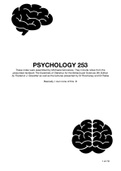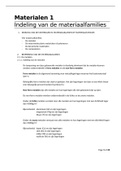Operations, management & logistics
SECTION 1: STRATEGY, PRODUCTS, AND CAPACITY
Chapter 1. Introduction
1-1 Identify the elements of operations and supply chain management (OSCM)
Operations and supply chain management involves specialists in:
- Product design
- Purchasing
- Manufacturing
- Service operations
- Logistics
- Distribution
Strategy <-> processes <-> analytics
Operations and supply chain management (OSCM): is defined as the design, operation, and
improvement of the systems that create and deliver the firm’s primary products and
services.
- Functional field of business with clear line management responsibilities.
- Is concerned with the management of the entire system that produces a product or
delivers a service.
1. Strategy, products, and capacity: how does the firm’s strategy impact its products
and processes?
2. Manufacturing and service processes: how are processes that transform resources
into products designed?
3. Supply chain processes: how are products moved through the supply chain?
4. Supply and demand planning and control: how are OSCM processes managed using
computer systems?
Supply chain: refers to processes that move information and material to and from the
manufacturing and service process of the firm.
Categorization of operations and supply chain processes
1
, 1. Planning: consists of the processes needed to operate an existing supply chain
strategically. Here a firm must determine how anticipated demand will be met with
available resources.
2. Sourcing: involves the selection of suppliers that will deliver the goods and services
needed to create the firm’s product. A set of pricing, delivery, and payment processes
are needed, along with metrics for monitoring and improving the relationships
between partners of the firm.
3. Making: is where the major product is produced, or the service provided
4. Delivering: logistics processes
5. Returning: involves processes for receiving worn-out, defective, and excess products
back from customers and support for customers who have problems with delivered
products
Key idea: Companies are positioned in different places in the supply chain. Within the
context of their position, they all require planning, sourcing, making, delivering, and
returning processes.
Key idea: The things produced by a service are intangible. Service processes tend to be
highly variable and time dependent compared to goods-producing processes.
Specifications of a service are defined and evaluated as a package of features
- Supporting facility (location, decoration, layout, architectural appropriateness,
supporting equipment)
- Facilitating goods (variety, consistency, quantity of the physical goods that go with
the service; for example, the food items that accompany a meal service)
- Explicit services: (training of service personnel. Consistency of service performance,
availability and access to the service, and comprehensiveness of the service)
- Implicit services (attitude of the servers, atmosphere, waiting time, status, privacy
and security, and convenience)
Product-service bundling: refers to a company building service activities into its product
offerings for its customers.
1-2 Know the potential career opportunities in OSCM
2
,Key idea: OSCM jobs focus on delivering the goods on-time and at low cost. They are
interesting, people-oriented jobs.
- Plant manager: oversees the workforce and physical resources required to produce
the organization’s product.
- Supply chain manager: negotiates contracts with vendors and coordinates the flow
of material inputs to the production process and the shipping of finished products to
customers.
- Purchasing manager: manages the day-to-day aspects of purchasing.
- Logistics manager: oversees the movement of good throughout the supply chain.
- Warehouse/distribution manager: oversees all aspects of running a warehouse,
including replenishment, customer order fulfilment, and staffing.
- Business process improvement analyst: applies the tools of lean production to
reduce cycle time and eliminate waste in a process.
- Project manager: plans and coordinates staff activities, such as new-product
development, new technology deployment, and new-facility location.
The COO works with the CEO and company president to determine the company’s
competitive strategy. COOs determine an organization’s location, its facilities, which vendors
to use, and how the hiring policy will be implemented.
1-3 Recognize the major concepts that define the operations and supply chain
management field
Many of the concepts in OSCM have their origins in the Industrial Revolution in the 1800s.
Just-in-time: is an integrated set of activities designed to achieve high-volume production
using minimal inventories of parts that arrive exactly when they are needed.
3
, Total quality control/management: aggressively seeks to eliminate causes of production
defects.
Business process reengineering: seeks to make revolutionary changes as opposed to
evolutionary changes (which are commonly advocated in TQM).
Supply chain management: central idea is to apply a total system approach to managing the
flow of information, materials, and services from raw material suppliers through factories
and warehouses to the end customer.
Mass customization: the ability to produce a unique product exactly to a particular
customer’s requirements.
Electronic commerce: refers to the use of the Internet as an essential element of business
activity.
Triple bottom line: a business strategy that includes social, economic, and environmental
criteria.
Business analytics: involves the analysis of data to better solve business problems. What’s
news is that mathematical tools are now readily available that can be used to support the
decision-making process.
Internet of things: refers to the billion of devices that are connected to the Internet.
Challenges in the future:
1. Uncertainty in global tariffs and regulations
2. Difficulty in hiring and keeping employees
3. Adapting to change in business technology and infrastructure
1-4 Evaluate the efficiency of a firm
Efficiency: means doing something at the lowest possible cost.
Effectiveness: means doing the right things to create the most value for the company.
Value: quality divided by price
Notes practice test
Benchmarking: a process in which one company studies the processes of another company
(or industry) to identify best practices.
Crash conversion cycle/ cash-to-cash cycle time: from purchasing raw materials to making
the product to selling the product to reusing the case to purchase more raw materials.
4
SECTION 1: STRATEGY, PRODUCTS, AND CAPACITY
Chapter 1. Introduction
1-1 Identify the elements of operations and supply chain management (OSCM)
Operations and supply chain management involves specialists in:
- Product design
- Purchasing
- Manufacturing
- Service operations
- Logistics
- Distribution
Strategy <-> processes <-> analytics
Operations and supply chain management (OSCM): is defined as the design, operation, and
improvement of the systems that create and deliver the firm’s primary products and
services.
- Functional field of business with clear line management responsibilities.
- Is concerned with the management of the entire system that produces a product or
delivers a service.
1. Strategy, products, and capacity: how does the firm’s strategy impact its products
and processes?
2. Manufacturing and service processes: how are processes that transform resources
into products designed?
3. Supply chain processes: how are products moved through the supply chain?
4. Supply and demand planning and control: how are OSCM processes managed using
computer systems?
Supply chain: refers to processes that move information and material to and from the
manufacturing and service process of the firm.
Categorization of operations and supply chain processes
1
, 1. Planning: consists of the processes needed to operate an existing supply chain
strategically. Here a firm must determine how anticipated demand will be met with
available resources.
2. Sourcing: involves the selection of suppliers that will deliver the goods and services
needed to create the firm’s product. A set of pricing, delivery, and payment processes
are needed, along with metrics for monitoring and improving the relationships
between partners of the firm.
3. Making: is where the major product is produced, or the service provided
4. Delivering: logistics processes
5. Returning: involves processes for receiving worn-out, defective, and excess products
back from customers and support for customers who have problems with delivered
products
Key idea: Companies are positioned in different places in the supply chain. Within the
context of their position, they all require planning, sourcing, making, delivering, and
returning processes.
Key idea: The things produced by a service are intangible. Service processes tend to be
highly variable and time dependent compared to goods-producing processes.
Specifications of a service are defined and evaluated as a package of features
- Supporting facility (location, decoration, layout, architectural appropriateness,
supporting equipment)
- Facilitating goods (variety, consistency, quantity of the physical goods that go with
the service; for example, the food items that accompany a meal service)
- Explicit services: (training of service personnel. Consistency of service performance,
availability and access to the service, and comprehensiveness of the service)
- Implicit services (attitude of the servers, atmosphere, waiting time, status, privacy
and security, and convenience)
Product-service bundling: refers to a company building service activities into its product
offerings for its customers.
1-2 Know the potential career opportunities in OSCM
2
,Key idea: OSCM jobs focus on delivering the goods on-time and at low cost. They are
interesting, people-oriented jobs.
- Plant manager: oversees the workforce and physical resources required to produce
the organization’s product.
- Supply chain manager: negotiates contracts with vendors and coordinates the flow
of material inputs to the production process and the shipping of finished products to
customers.
- Purchasing manager: manages the day-to-day aspects of purchasing.
- Logistics manager: oversees the movement of good throughout the supply chain.
- Warehouse/distribution manager: oversees all aspects of running a warehouse,
including replenishment, customer order fulfilment, and staffing.
- Business process improvement analyst: applies the tools of lean production to
reduce cycle time and eliminate waste in a process.
- Project manager: plans and coordinates staff activities, such as new-product
development, new technology deployment, and new-facility location.
The COO works with the CEO and company president to determine the company’s
competitive strategy. COOs determine an organization’s location, its facilities, which vendors
to use, and how the hiring policy will be implemented.
1-3 Recognize the major concepts that define the operations and supply chain
management field
Many of the concepts in OSCM have their origins in the Industrial Revolution in the 1800s.
Just-in-time: is an integrated set of activities designed to achieve high-volume production
using minimal inventories of parts that arrive exactly when they are needed.
3
, Total quality control/management: aggressively seeks to eliminate causes of production
defects.
Business process reengineering: seeks to make revolutionary changes as opposed to
evolutionary changes (which are commonly advocated in TQM).
Supply chain management: central idea is to apply a total system approach to managing the
flow of information, materials, and services from raw material suppliers through factories
and warehouses to the end customer.
Mass customization: the ability to produce a unique product exactly to a particular
customer’s requirements.
Electronic commerce: refers to the use of the Internet as an essential element of business
activity.
Triple bottom line: a business strategy that includes social, economic, and environmental
criteria.
Business analytics: involves the analysis of data to better solve business problems. What’s
news is that mathematical tools are now readily available that can be used to support the
decision-making process.
Internet of things: refers to the billion of devices that are connected to the Internet.
Challenges in the future:
1. Uncertainty in global tariffs and regulations
2. Difficulty in hiring and keeping employees
3. Adapting to change in business technology and infrastructure
1-4 Evaluate the efficiency of a firm
Efficiency: means doing something at the lowest possible cost.
Effectiveness: means doing the right things to create the most value for the company.
Value: quality divided by price
Notes practice test
Benchmarking: a process in which one company studies the processes of another company
(or industry) to identify best practices.
Crash conversion cycle/ cash-to-cash cycle time: from purchasing raw materials to making
the product to selling the product to reusing the case to purchase more raw materials.
4










